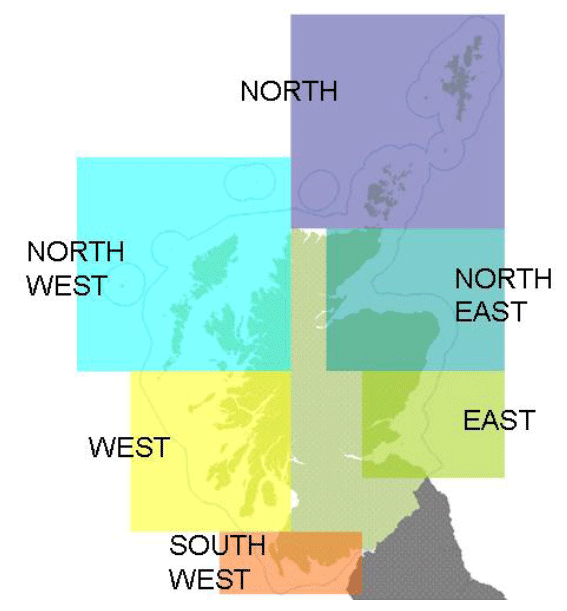Draft Sectoral Marine Plans for Offshore Renewable Energy in Scottish Waters: Consultation Paper
The Draft Sectoral Marine Plans for Offshore Wind, Wave and Tidal energy in Scottish Waters represent Scottish Ministers' proposed spatial policy for the development of commercial scale offshore renewable energy at a national and regional level.
1. INTRODUCTION
1.1.1 The Scottish Government has introduced a system of sectoral marine planning to facilitate the sustainable development of offshore renewable energy in Scottish Waters (0 - 200 nm). The Draft Sectoral Marine Plans for Offshore Wind, Wave and Tidal Energy in Scottish Waters represent Scottish Ministers' proposed spatial policy at the national and regional level for the development of commercial scale offshore renewable energy in Scottish Waters.
1.1.2 The Offshore Renewable Energy Regions within Scottish Waters have been used to provide a regional breakdown in the Draft Plans. The Final Draft Plans will align with the Scottish Marine Regions once they are confirmed by the Scottish Parliament.
Fig.1 Scottish Offshore Renewable Energy Regions ( SORERs)

Strategic Aims
1.2.1 The Draft Plans are based on the following strategic aims:
- Maximise the contribution that offshore renewable energy makes to renewable energy generation in Scotland;
- Maximise opportunities for economic development, investment and employment;
- Minimise adverse effects on people, other sectors and the environment;
1.2.2 In relation to the development of offshore renewable energy around Scotland, the Plans form an integral part of a series of initiatives which include:
- Scotland's Offshore Wind Industry Route Map,
- Scotland's Marine Energy Action Plan
- National Renewables Infrastructure Plan (N-RIP), and
- Securing the Benefits from Scotland's Next Energy Revolution
1.2.3 These initiatives have been put in place to help facilitate green energy development in the marine environment. Additionally the Drafts Plans seeks to deliver Scottish Ministers' policies for green energy, thereby helping to meet our carbon reduction targets [1] .
Delivering the benefits from Offshore Renewable Energy
1.3.1 Scotland has considerable potential for offshore renewable energy developments. Estimates indicate that Scotland has up to 25% of Europe's offshore wind potential [2] , 25% of Europe's tidal potential, and 10% of Europe's wave energy resources.
1.3.2 From an environmental perspective, the Draft Plans recognise that offshore renewable energy is an integral element in Scotland's contribution towards action on climate change. Emissions of green house gases (ghgs) should reduce through a shift from the use of carbon based fossil fuels to the production of cleaner and greener energy.
1.3.3 The large scale development of offshore renewable also represents one of the biggest opportunities for sustainable economic growth in Scotland for a generation. The Draft Plans recognise that ports and harbours present viable locations to service the associated construction and maintenance activities for offshore renewable energy. In addition, Scottish research institutions provide a base of academic excellence for delivering technological advancements and technology transfer and are also well placed to benefit from the creation of this new industry around Scotland.
The Challenges
1.4.1 Development should be both sustainable and seek to accommodate public and community views. The Draft Plans identify national and regional issues for offshore renewable energy development. They recognise the role Marine Licensing will play and highlight environmental, socio-economic and public concern issues which will require further consideration as the Plans are progressed.
1.4.2 From an economic perspective, Scotland has to compete with the rest of Europe and globally to maximise its share of the renewable energy market. The Draft Plans represents an early opportunity to identify key strategic issues and potential mitigation measures in order to help avoid unnecessary delays in the later stages of the development process when tackling such issues could prove more challenging. As a consequence, this should contribute to the competitiveness of Scotland as a location for offshore renewable energy development as it will be made it clear to developers and supply chain companies where development is possible, what the main challenges will be and where and what further opportunities Scotland can provide.
1.4.3 A further key challenge to the development of offshore renewable energy around Scotland is access to appropriate grid infrastructure. The Draft Plans, along with the development of the Scottish National Marine Plan and Scotland‟s emerging third National Planning Framework (NPF3), will therefore serve as the basis upon which a strategic planning exercise for the provision of grid infrastructure can take place. In addition, by considering access to Scotland‟s vast offshore energy resource at the strategic level, it will enable further planning exercises to support emerging technologies which can deployed at further and more remote locations of the Scottish Marine Area. The Main Issues Report for NPF3 emphasises the importance of terrestrial planning working alongside marine planning to play a positive role in facilitating offshore energy development. As well as updating the support for grid infrastructure provided in NPF2, it proposes a new national development focusing specifically on onshore infrastructure requirements for offshore renewable energy developments.
1.4.4 Following adoption of the Sectoral Marine Plans for Offshore Wind, Wave and Tidal Energy in Scottish Waters, a strategic planning exercise for the provision of grid infrastructure will be undertaken. This exercise will be taken forward applying a sustainability appraisal approach including strategic environmental assessment, socio-economic assessment, strategic habitats regulations appraisal and consultation analysis.
Contact
There is a problem
Thanks for your feedback